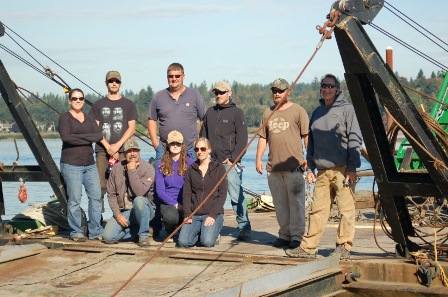
The Government Island Grassland Enhancement project work crew before equipment is barged off the island.
September 21, 2015: The Port of Portland ecologists and partners looked on in disappointment as the truck and trailer carrying the seed and drill seeder sunk deep into the dry sand of the Columbia River’s shoreline. After a long day of transporting equipment from Albany to Portland and barging it to Government Island, it was hoped that moving it to the project site would go smoothly. Now, two miles of thick brush separated the equipment from the 50-acre grassland restoration area. Given the soft sand, a new pathway had to be identified to accommodate the tractor and 13-foot wide drill seeder as the trailer wasn’t going anywhere. Enhancing grassland in this area was already proving to be a challenge.
If you’ve worked with machinery in enhancement projects before, you know the feeling of disappointment when things go wrong. Equipment needed for large-scale work can be difficult to move in natural areas – especially on an isolated island. Transporting a crew of seven contractors to an island each day – by boat or drop-off along I-205 – adds logistical complexity. In this week, a crew of seven will blaze a new cross-island route, repair equipment, and seed 630 pounds of wildflower and grasses all in an effort to enhance habitat to help pollinators and grassland birds.
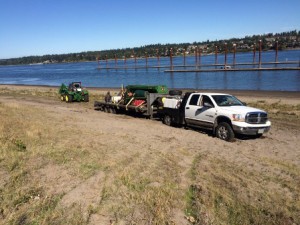
Truck and trailer used to bring tractor, seed drill, native seed and bulbs, equipment and supplies stuck in the soft sand.
Planning for Pollinators
Bees, butterflies and other pollinators maintain healthy ecosystems and, unfortunately, their populations are declining. Habitat loss affects pollinator populations – especially the loss of native plant species. Oak prairie communities have particularly suffered as the region developed, with only one percent remaining from the original landscape. Both grassland diversity and associated pollinators are topics of conservation concern in the Portland metropolitan area; many organizations collaborate through the Intertwine Alliance’s Oak Prairie Work Group.
Port of Portland manages more than 800-acres of mitigation lands using the latest applied science and restoration techniques. The Government Island Grassland Mitigation project is a result of the Airport Futures planning process that assessed natural resources and future Portland International Airport development needs in the plan district.
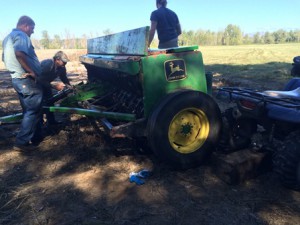
Tenbusch Farms and Pacific Northwest Natives staff calibrate the seed drill for operation.
Partnering on Research
In designing the enhancement project, the Port took an innovative approach by conducting research in partnership with the Xerces Society. The Port contracted with the Xerces Society to monitor pollinators before and after site enhancement to understand how establishing native grasses and wildflowers would change the diversity and abundance of pollinators. It is hypothesized that as the plant community changes from non-native and invasive species to a native bunch grass and flowering species composition, a positive increase in native bee abundance and diversity should result. Monitoring will continue for three years following seeding.
To gather pre-enhancement data, Xerces staff monitored pollinators once a month from May through September, 2012. Monitoring protocols included bee bowls and butterfly transects. Bee populations are the primary focus of Xerces’ survey efforts, but butterflies and other pollinators are noted as well. Post-implementation monitoring will provide data on changes in those populations for analysis.
Given their importance to the health of terrestrial ecosystems, pollinators represent a unique metric for evaluating restoration project success. While traditional mitigation efforts focus on native plant establishment rates (and corresponding weed pressure) as success measures, the inclusion of pollinator monitoring by the Xerces Society quantifies functional ecosystem services. The Port, by initiating this research, gains useful insights for grassland restoration that can inform mitigation projects and help ecological restoration partners.
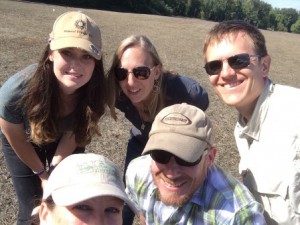
Port of Portland ecologists Sarah Wilson, Maureen Minister, Carrie Butler and Matt Paroulek and Jim Eckberg from Xerces Society
Enhancing Our Grassland Habitat
Port staff are taking an adaptive management approach with Phase 1 to refine best practices in grassland enhancement. Discussions with researchers and other groups restoring prairies in Oregon, such as the Institute for Applied Ecology, the Xerces Society, The Nature Conservancy, the Audubon Society and the City of Portland, informed the initial project design. For Phase 1, Port staff will evaluate site preparation, fall seeding and seed mix strategies to see if outcomes meet the seven vegetative conditions targeted by this project. Information will refine future project planning.
The diverse seed mix included a broad diversity of native wildflower and grass species to evaluate what species thrive in the unique island landscape. Given the low topography and frequent disturbance, the site aligns most closely with a wet meadow community; however elevations do vary throughout the site. The species mix offers staggered blooms to provide pollinators with nectar and food throughout the growing season. In addition to seeding, Port staff hand planted 2,000 Camas bulbs.
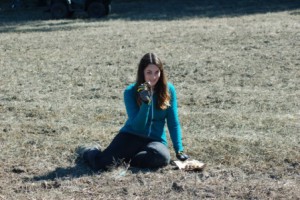
Sarah Wilson shows one of the Camas bulbs planted at the site.
Prior to seeding, the site preparation included mowing and careful application of herbicide over several years to bring the site from an association of thick pasture grass and invasive broadleaf species to a site that is mostly bare ground. The late September 2015 planting week coordinated Port staff with experts from the Xerces Society, Pacific Northwest Natives and Tenbusch Farms over five days to get all the seed planted. Everyone felt fortunate when rains held off until the end of the week when seeding was complete.
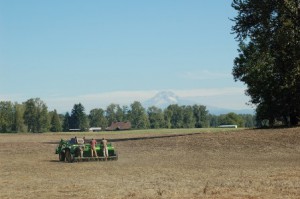
Contractors ride on the back of the seed drill to manually agitate the seed mixture, ensuring consistent seed coverage of the planting site among lighter and heavier seeds.
Considering Our Future
Looking to the future, pollinator, wildlife and vegetation monitoring will continue in 2016. The results will inform planning of Phase 2 that will include 50 acres of additional grassland mitigation to begin when triggered by 25 acres development on airport land. In a few years, data will yield insights to determine if pollinator abundance and diversity correlates with grassland enhancement success. In the meantime, the team eagerly awaits spring and new challenges as work continues on Columbia River’s largest grassland mitigation project and innovative pollinator research.

